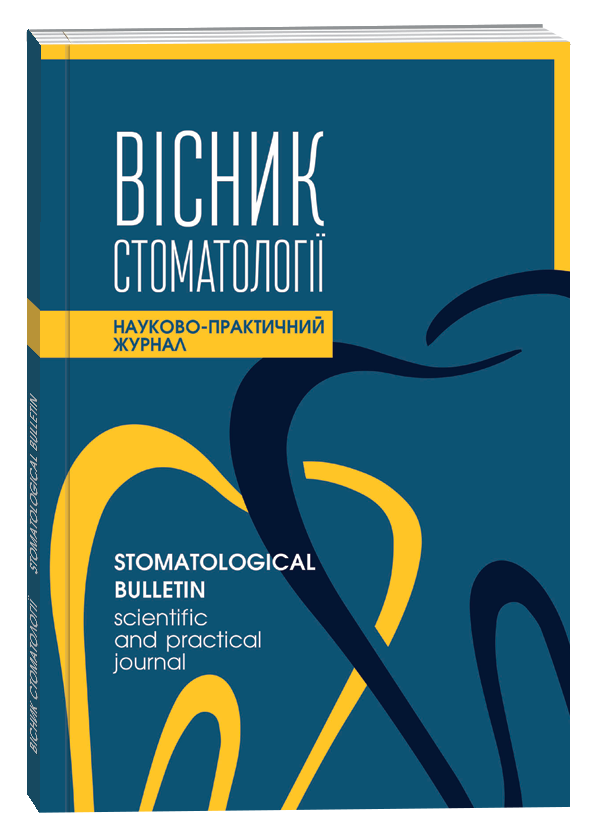COMPARATIVE CHARACTERISTICS OF DENTAL DEFECTS AND THE VOLUME OF IMPLANTOLOGICAL CARE IN THE YOUNG POPULATION OF UKRAINE
DOI:
https://doi.org/10.35220/2078-8916-2022-44-2.11Keywords:
dental implants, dentition defects, need and availability.Abstract
In the course of the work, a comparative analysis of the prevalence, topography, and structure of dentition defects in the young population of Odessa and Ivano- Frankivsk was carried out, and based on these data, the need of this population group for dental implants as supports for fixed orthopedic structures was scientifically justified. Also, during the examination of dental examinations, the availability of this type of care was studied. Materials and methods. According to WHO recommendations, the following age groups were formed: 15–19, 20–24, 25–29 years. The number of people surveyed in each age group was 70 people. During the examination, only somatic individuals who did not have contraindications to dental implantation were included in the examined groups. A total of 420 people were examined in Ivano-Frankivsk and Odessa in the age group of the survey. The results obtained were recalculated per 1000 people of the population. Results and their discussion. When analyzing the data obtained, the following patterns are observed: a larger number of people in all age categories who do not have dentition defects, among residents of Odessa. Residents of Ivano-Frankivsk in all age groups were found to have a significantly higher total number of defects than among residents of Odessa. It is also noteworthy that among the residents of Odessa in the age group of 15–19 years there are no distal-unlimited defects, at the same time, among the residents of Ivano-Frankivsk, this figure was 57.1 people. For residents of m. Odessa of young age has no defects with a length of 4 teeth, at the same time, residents of Ivano-Frankivsk in the age group of 25–29 years had 100 such people per 1000 people of the population. Of the 210 young residents of Odessa examined, 9 people had orthopedic structures supported by Dental Implants (16 implants were installed there). Among the residents of Ivano-Frankivsk, out of 210 examined, 7 people had orthopedic structures supported by dental implants (they had 12 implants installed). Based on the data obtained, the need of the young population of Odessa for implants is 9.7 % of the total need. Among the residents of Ivano- Frankivsk – 4 % of the need. Based on the conducted research the following conclusions were drawn: 1. A significantly higher number of defects was found in residents of Ivano-Frankivsk in all age groups of the young population compared to residents of Odessa. 2. The young population of Odessa for the purpose of manufacturing fixed orthopedic structures based on Dental Implants needs to install 2364 implants per 1000 people, and in Ivano-Frankivsk – 4171, while the availability of dental implants among residents of Odessa is 9.7 % of the need, and among residents of Ivano-Frankivsk – 4 %.
References
Хватова В. А. Диагностика и лечение нарушений функциональной окклюзии: руководство. Нижний Новгород, 1996. 276 с.
Сидоренко Л. П., Вдовенко Л. П., Ожоган З. Р. Особливості клінічної картини у осіб молодого ріку і з малими дефектами зубних рядів. Дентальні технології, 2006. 3. С. 2–6.
Окклюзия и клиническая практика / под ред. И. Климберга, Р. Джагера; пер. с англ. М. М. Антоник. М. : МЕД проесс-информ, 2006. 200 с.
Захарова Г. Є. Зміни структури оклюзійної поверхні зубних рядів внаслідок втрати перших постійних молярів. Сучасна стоматологія. 2007. № 3 (39). С. 132–137.
Жегулович З. Е. Клинический анализ функционального состояния жевательного аппарата с применением Axioquick – recorder. Современная стоматология. 2008. № 1. С. 196–200.
Дмитренко І. А., Ожоган З. Р. особливості стану зубо-щелепної системи у хворих із середніми і великими дефектами зубних рядів. Український стоматологічний альманах. 2014. 4. С. 27–31.
Заблоцкий Я. В. Новая философия ортопедического лечения включенных дефектов зубных рядов несъемными протезами с использованием имплантатов. Часть II. Отсутствие двух и более зубов. Современная стоматология. 2003. № 3. С. 85–94.
Кулаков А. А., Лосев Ф. Ф., Гветадзе Р. Ш. Зубная имплантация. М. : МИА, 2006. 152 с.
Матвеева А. И., Агеенко А. М., Канатов В. А. и др. Показания и противопоказания к ортопедическому лечению дефектов зубных рядов с применением имплантатов (обзор). Стоматология. 1989. № 6. С. 76–79.
Лабунець В. А. Розробка наукових основ планування стоматологічної ортопедичної допомоги на сучасному етапі і розвитку : автореф. дис. ... д. мед. наук: 14.01.22. Київ. 2000. 37 с.
Заблоцький Я. В. Поширеність та структура дефектів зубних рядів у населення м. Львова та Львівської області / Я. В. Заблоцький, Н. М. Дидик // Вісник стоматології. – 2005. – № 4. – С. 77–87.
Лабунец В. А., Диева Т. В., Семенов Е. И. и др. Распространенность, интенсивность, структура, тенденции развития малых включенных дефектов зубных рядов у лиц молодого возраста и их ослонений. Вісник стоматології. 2013. № 1. С. 93–100.
Стоматологические обследования: основные методы. Женева ВОЗ, 1989. – 62 с.








